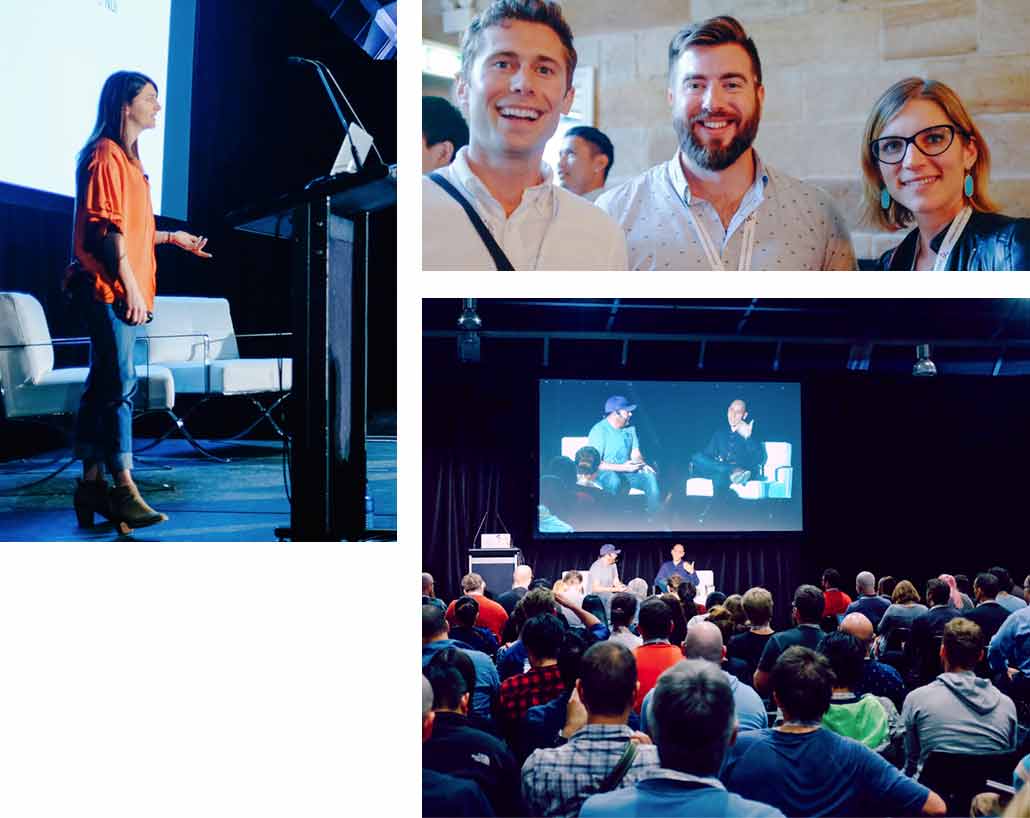Why Code?
The Front End technology stack constantly changes, along with best practice in performance, security, workflow and more. Keeping up with these developments can feel like a full time job.
At Web Directions, we've lived and breathed the web for more than 20 years, and use this unique perspective and deep knowledge to curate Code: two days of in-depth, invaluable presentations from local and world leading experts to help you and your team stay ahead.
Who's it for?
Whether you call yourself a coder, a programmer a developer or engineer, if your job is to build and deliver robust, fast, secure, engaging web experiences, Code is for you.
Code is for front end engineers: JavaScript and Web developers, engineering leads, engineering managers, devops experts, CTOs.
Real World Knowledge
Now in its eigth year, Code is carefully curated by John Allsopp, whose deep knowledge of the Web over two decades as a developer, author and speaker ensures a program of genuine relevance and value.
Our program routinely features members of the W3C's Technical Architecture Group, ECMA TC39 (the JavaScript standards committee) and others shaping the foundations of the Web. Past speakers have included Alex Russell (inventor of Progressive Web Apps), Rachel Nabors, Barbara Bermes, and Domenic Denicola).

- 350+ Passionate attendees
- 20 Transformational speakers
- 2 Intense Days
Code is now sold out
Sadly for the third year running Code has now sold out. But there are still some options if you missed out:
- Get on the waitlist, to pick up a cancellation, and make sure you dont miss out in 2020
- There are still some places at our Code Leaders conference, the day before Code
- Come to our free evening with MelbJS, and hear Asim Hussain and Laurie Voss the night before Code.
- Come to our Summit in Sydney October 31 and November 1, with a dedicated front end engineering track
Get on the waitlist
Extraordinary speakers
We've assembled a worlds class lineup of front end developer experts, including:

The Evolution of Web Development
Erwin van der Koogh Founder Linc
Just like in the amazing “Evolution of Dance” video we will be going through all the major highlights of the last few decades, except in relation to web development instead of dance.
But very much unlike in “The Evolution of Dance” we won’t stop in the present and will be projecting where Web Development is going so that we can explore interesting questions like:
- “What capabilities should I be investing in right now?”
- “What is the impact of microservices on front-end development?”
- “How do we deliver Javascript based applications to the next billion users who can’t really run Javascript?”
- And; “What is that server doing in my front-end?”
I am not saying there will be any dancing involved, but I am also not saying there won’t be any dancing either.
Read More

The Metric System: Making Correct Performance Measurements
Henri Helvetica Performance Engineer Independent
Some who have been present on the web a little whilst might still remember one of the preeminent debugging tools: FireBug. For all its features and early praise, its author Joe Hewitt initially created it for 2 reasons: to observe what was happening on a page, pre and post resource load. Two simple metrics.
A decade and change later, measuring resource loading and page performance is in equal parts proof and perception. The multitude of metrics available has allowed for granular measurements, but has also clearly created confusion.
During 'The Metric System', we will learn about many of the performance metrics being bandied around like FCP, FMP, TTFB and Speed Index to name a few. But more importantly, we will see how to interpret this data, when to use it in order to extract the information our individual users need for the best user experience possible.
Read More

When Your Code Does a Number on You: Navigating Numbers in JavaScript
Meggan Turner Software Engineer Jaxsta
What happens when the numbers you’re working with are too big for JavaScript? How do numbers behave beyond JavaScript’s integer limit?
In a talk which promises to be more interesting than your typical high school math class, Meggan takes you down the rabbit hole that is numbers in JavaScript. We’ll explore how they’re implemented, how we can best write, format, convert & calculate them, and what to do when we’re forced to handle really big (or really small) numbers.
Read More

WebAssembly, your browser's sandbox
Aaron Powell Regional Cloud Developer Advocate Microsoft
We've been doing web development for 30+ years and in all that time have you ever stopped to think, "This SPA needs more C++"? Well thanks to the power of WebAssembly you can finally bring C, C++, Rust, Go and other high level languages to the browser.
So does this mean that we can replace our JavaScript with these other languages? Probably not, so what is the role that WebAssembly can play in building web applications? And most importantly, what does it look like as a web developer to try and incorporate these platforms that have traditionally been on the server?
For this talk, we'll look at some of the fundamentals of WebAssembly, how to incorporate it into our development process and ultimately what it looks like to build an application that uses a mixed development stack.
Read More

Compression: slashing the bytes for faster web apps
Neil Jenkins Front-end Engineering Lead Fastmail
We all know that compression is essential for delivering fast web apps. But how does it work? Is it just ✨magic✨?
We'll take a look at how compression shaves bytes off your downloads under the hood, and at what impact this can make on your page load time. Then we'll see how we can use JavaScript to compress your *uploads* too, turbo charging your SPA in poor network conditions.
Read More

How to AI in JS?
Asim Hussain Regional Lead, Dev Rel Microsoft
There are many exciting things happening with AI, from which, until recently, JavaScript developers were largely shut out. But things are changing, if you can do `npm install @tensorflow/tfjs` or make an API call, you can now do AI.
Read More

In conversation with a browser
Phil Nash Developer Evangelist Twilio
Newer developments in CSS make it easier than ever to create robust, scalable, elegant typographic systems on the web and in apps. But the fun really starts when you add Variable Fonts. The design, technical, and performance benefits are really exciting, but when you combine them with other CSS capabilities like custom properties, calculations, and grid it’s a whole new way to think about design and development.
We’ll see how they work together by using some variable fonts in layouts that work across screen dimensions, accessibility needs, design requirements, and even network speeds—better than you thought possible.
Read More

It's time to hit record: an introduction to the Media Recorder API
Jessica Edwards UX Developer Canva
If you haven't attempted to get media out of web page before, you can be forgiven for thinking it would be a simple exercise. For a long time however, anything beyond a trivial static frame varies between an arduous exploration of an excessive amount of web APIs, to downright impossible without talking to a server.
Fortunately, the Media Recorder API helps to address this issue. Without any plugins, extensions, or any back-end code, we can generate a piece of original video content solely in the browser! ...with some caveats. We'll go through what you can do with Media Recorder and other related APIs, what you can't, and what's on the horizon.
Read More

Building secure web experiences with Passwordless Authentication
Matthew Kairys Software Engineer DiUS Computing
Without question, passwords have failed us time and time again. Data breaches and phishing attacks are on the rise and studies consistently show they are often the result of weak and/or stolen passwords. With the recent standardisation of Web Authentication by W3C, developers can now give users and businesses more options to protect themselves on the web.
In this talk, we’ll examine how developers can use the Web Authentication API to build secure user experiences in web apps using passwordless authentication. We’ll review best practices and integration challenges and demonstrate how you can put this into practice today.
Read More

Securing JavaScript
Laurie Voss CDO npm Inc.
Usage of open-source JavaScript modules has grown more than 25,000% in the last 5 years. An average modern web app has 2000 modules in it, and a big company will be using more than 20,000 different packages.
All this code re-use is great, but processes for tracking and securing open source code in other languages don't fit the scale and speed at which JavaScript operates. We'll talk about how we got here, and how to keep your apps secure in the JavaScript-heavy development stack of 2019, as well as some other recent improvements in npm that can help your team work together better and faster.
Read More

Building a new Web Browser in 2019
Yuriy Dybskiy Founder Puma Browser
Building a new browser might sound like a crazy idea. In this session we'd like to walk you through why we decided to build Puma Browser, why we think it's important for the future of the web, what is Web Monetization Spec and Interledger Open Protocol.
Read More

Front end migrations in legacy code
Tanvi Patel Software Engineer Uber
From plain old JavaScript to jQuery to React / Angular! How do you deal with migrations to newer front end tech stack? Or even worse, how do you introduce newer technology within legacy code jungle?
This talk will provide helpful suggestions on how to deal with the tangled web of legacy code created over time. It will address approaches to effectively plan for refactoring to comply legacy code with a modern framework.
Read More

Picking up the pieces - A look at how to run post incident reviews.
Klee Thomas software engineer nib
We all know that the beautiful world of software is like a basketball balanced on a Jenga game. It's fine while it's fine but all it takes is a semi colon in the wrong place, a bad database failover or some unlucky road worker to cut a cable and the whole world comes crashing down. Fortunately we're all good people and when the pieces are on the floor we pull together and get it all balanced again. But then what?
It’s not good enough to just forget about it. Sweep it under the run and pretend it never happened. Production incidents are part of life. More than that, they are great learning opportunities. By examining what went wrong and identifying the contributing factors, we can not only learn how to prevent this happening again, but also pre-empt other issues within our system.
This talk looks at the strategies for Post Incident Review starting with the common place practices including the Fishbone Diagrams, Sticky Note Brainstorming and the Five Whys methods of root cause analysis. This talk will go beyond these practices to show how leveraging modern monitoring practices along side ChatOps we can the contributing factors, not just a single cause.
These contributing factors can be used to find actionable outcomes that not only help prevent the same thing happening again but feed back into the incident life cycle to make the team better prepared to Detect, Respond to, Remediate and Analyse the next incident.
Read More

From DevOps to a DevOps Culture
Michelle Gleeson Technical Practice Lead SEEK
If your organisation is more than five years old, chances are you are familiar with the pain of the monumental shift of your legacy stack towards small, more deployable software, running on cloud infrastructure. Oh, how we all envy the start up! We worked hard to get there, but where has this left us?
Our teams ship software daily and work autonomously but is that enough to claim we are high performing? In this session we will talking about taking stock when the dust settles, and what you can do to help your team build a strong culture in a DevOps world.
Read More

The Anthropology of Testing: Past, Present and Future
Michel Boudreau Co founder Pact Foundation
Testing has come a long way from the days of mechanical computers, which has evolved side by side with our coding practices and culture. Before we can learn where we are and where we should be going, let's glance backwards to where it all began.
Read More

Super Hero Layouts
Anton Ball Developer Seven West Media
Modern CSS layout techniques opened a world of possibilities. Layouts previously thought impossible become possible. A great way of mastering techniques is through play, so I turned to one of my favourite hobbies - comic books.
Taking well known layouts, how could they be built in a browser? There’s uneven shapes, ever changing layouts and compositions? This talk is going to dive into modern CSS layout techniques to recreate elements of comic books with CSS Grid, writing mode, CSS shapes and more. Come along to see CSS layouts at play.
Read More

Let's build a web component!
Erin Zimmer Senior Developer Shine Technologies
The time has finally come for web components. The specs have been standardised. They’re now (or soon to be) supported in all modern browsers. You can use them with your favourite framework.
So, how do you get started? There are a bunch of libraries around that can help you build web components. But, to help you really get what they’re about, we’re going to build one from scratch, on stage, in twenty minutes.
No frameworks, no libraries, no build tools. Just you, me and an IDE.
Read More

The Other 6 Billion
Jason O'Neil Front End Engineer Culture Amp
The web aims to be an inclusive platform, and when it comes to making our websites and apps more comfortable for a wide variety of people, we love to sweat the details: responsive design, accessibility, browser support. But what about the 6,000,000,000 people who don’t speak English? How can we make our online experiences accessible to everyone who speaks a language different to our own?
Let’s explore how the web standards in our toolkit can help build better experiences for people who don’t speak the same language as us. How do you translate videos or SVGs? Which HTML elements and CSS properties are likely to trip us up? How do Flexbox and CSS Grid help us build interfaces that support writing systems that flow in different directions to ours?
This talk will focus on practical front-end advice for localisation on the web - things I’ve learned while making our company’s platform available in 46 different languages - and show how our localisation efforts are a key part of building an inclusive web.
Read More

Designing with Components
Mark Dalgleish Front-end Infrastructure Lead SEEK
Thanks to modern component-oriented architecture, the front-end community has been naturally gravitating towards design systems as a way of standardising our respective design languages into reusable components. When done successfully, it suddenly becomes trivial to translate standard designs into code. In fact, we may even find that this translation step starts to feel somewhat redundant.
In a world of components, how should our design processes change? How should our tooling change? How should we, as front-end developers, better enable this change? In this talk, we'll look at the current state of design and development, and where we could go—if we're willing to push for it.
Read More

Planning Your Progressive Web App
Jason Grigsby Co-founder Cloud Four
If you have a website—particularly one that generates revenue for your organization—you need a Progressive Web App. So where do you begin? How do you decide which features of a Progressive Web App make sense for your users? What tools can make the process easier (or harder)? In this practical session, Jason will guide you through the key design decisions you’ll need to make about your Progressive Web App and how those decisions impact the scope of your project. He'll also teach you how to avoid common pitfalls and help you take full advantage of Progressive Web App technology.
Read More
Our venue
Code 2019 will again be held in the Pavilion at the iconic Arts Centre Melbourne, right on the Yarra in Southbank.
The Pavilion,
Arts Centre Melbourne,
100 St Kilda Road, Melbourne
Getting there:
With excellent public transport connections right outside, and Flinders Street Station right across the bridge, it's our best connected location yet.
Accommodation:
If you're coming from out of town, there are many hotel and serviced apartments style accommodation options in Southbank, and otherwise close by. We have for some time put our speakers up at the Quest Southbank Apartments, and stay there ourselves.
Partners
At Web Directions we work closely with partners to help make our events even better. Sponsor our coffee, reception, recharge station, or other valued activities and start or grow your relationship with our highly qualified audience.
Contact us for more on how we work can work with you to help you be even more awesome.
Key Partners
Meetup Muster Partners

Season PassesChoose a pass across 2, or all 3 of our major 2020 events, and get a Gold ticket which includes conference video, speaker dinner at each, and more. You can even pay quarterly to manage cashflow. Just register then contact us and we'll set it all up. Passes are for a single named attendee across all events, and are not transferable between attendees. For teams we have great group pricing, contact us for more. |
Complete Season Pass
|
Three Conference Pass
|
Two Conference Pass
|
|
|
|
|
Find the season pass for you
Complete Season Pass
A Gold ticket to every one of our main 2020 conferences
Bonus Silver ticket to our Design Leaders and Code Leaders conferences
- $3,495
before Feb. 28
A Gold ticket to all three of our main 2020 conferences
Bonus Silver ticket to a choice of Code Leaders or Design Leaders
- $2,995
before Feb. 28
Two Conference Pass
A Gold ticket to your choice of two of our main 2020 conferences
- $1,995
before Feb. 28
Praise for past Web Directions events

Web Directions is the must-attend event of the year for anyone serious about web development.
Phil Whitehouse,
Innovation Lead DigitasLBi

I’ve been admiring the Web Directions events for years, and was honored to be part… What a fantastic event!
Ethan Marcotte,
inventor "responsive Web design"

Out of any conference, Web Directions is far and away our favourite
Dave Greiner,
founder Campaign Monitor
About Us
Co-founded and now run by John Allsopp, Web Directions has for nearly 20 years brought together leading developers, engineers, visual, IxD, UX and product designers, Art and Creative Directors, product managers indeed everyone involved in producing web and digital products to learn from one another, and the World's leading experts across this vast field.
We spend our lives thinking about what comes next, keeping up with trends in technology, practices and processes, and filtering the hype, to make sure you don't miss trends that matter, and don't waste time on hype that doesn't.
We promise attending one of our events will leave you significantly better versed in the challenges you face day to day, and in solutions for addressing them.

John Allsopp
John Allsopp has been working on the Web for nearly 30 years. He's been responsible for innovative developer tools such as Style Master, X-Ray and many more. He's spoken at numerous conferences around the World and delivered dozens of workshops in that time as well.
His writing includes two books, including Developing With Web Standards and countless articles and tutorials in print and online publications.
His "A Dao of Web Design" published in 2000 is cited by Ethan Marcotte as a key influence in the development of Responsive Web Design, who's acclaimed article in 2010 begins by quoting John in detail, and by Jeremy Keith as "a manifesto for anyone working on the Web".
Code of Conduct
For over a decade, we've worked hard to create inclusive, fun, inspring and safe events for the Web Industry.
As part of our commitment to these values, we've adopted a code of conduct for all involved: ourselves, our speakers, our partners and our audience.
If you have any concern or feedback, please don't hesitate to contact us.